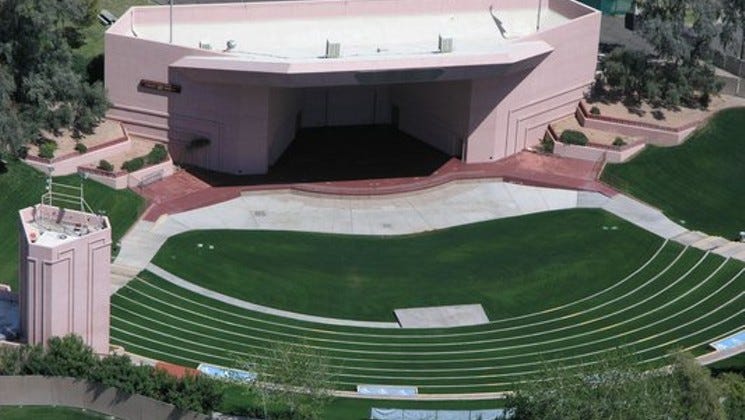
This date presents an intriguing and rare occurrence: an outdoor Phish show in December. With one rather notable exception, December shows are played in the Northeast and, for obvious reasons, under a roof. But thanks to the desert climate of Southern Arizona, Phish is able to sneak in one last outdoor appearance for 1994, an odd enough fact for Trey to mention it and offer this post’s titular advice before the “17-minute-long pause” of the setbreak.
The strange circumstances offer an opportunity to tease apart the differences between outdoor and indoor Phish without the usual seasonal influences. To state the obvious, outdoor shows are typically in summer, indoor shows are typically in fall. And most Phish fans will tell you there’s a big difference between indoor shows and outdoor shows, from aesthetic properties such as two full sets of Full Kuroda versus daytime and nighttime sets to deeper theories about the nature of improvisation in a shed versus an arena. But is it just being in an enclosed space that makes those fall/winter dates so special — enough so that the old-school common wisdom on “best Phish months” remains Decembers ‘95 and ‘97 — or are they just more warmed-up at the end of a year than at its beginning/middle?
By 1994 Phish hadn’t quite bifurcated in this fashion — indoor and outdoor shows still largely feel the same up to about this point, because most shows have a uniform vibe. But the music inside the theaters and gyms of this fall have definitely started sketching out the stereotype of what indoor Phish should sound like: deeper, darker, and more challenging. So Mesa is an early chance to ask the question of whether that approach would transfer to an outside setting, or whether the fresh air would nudge the needle back towards the party-band moves of summer.
The band answers by playing what would be a perfect capper to this sprawling, breakthrough tour...if not for the inconvenient reality of another show the following night. It’s a lot of fun overall, and refreshingly shakes off the doldrums of the California shows. But two jams in particular provide a strong argument that the experimentalism of the fall would translate just fine to outdoor venues, foreshadowing the extremities of Summer 1995.
They’re a little slow to warm up on this night in the desert, but by the time they finish the set-closing Antelope, they’re engulfed in flames. I haven’t been keeping track, but I’d say this is probably my favorite Antelope of the tour; I can’t remember another version that matches its sustained intensity. By the time it gets to “The Force Theme” tease kicking me right in the nostalgia, I’m drooling...and there’s still seven minutes left to go. Beyond the impressive wall of noise in the middle, it’s also thrilling how they blow past the obvious off-ramps to the “Rye Rye Rocco” section, forcing Fish to keep doubling his double-time until he’s practically a hardcore drummer. It’s even got a “suck the deer shit from the side of this hole” alternate ending to top it off.
Then there’s the Tweezer, which I’m also tempted to call my tour favorite despite the many historic versions that precede it. It’s in the ballpark of the runtime of Bozeman and Bangor but without as much wheel-spinning, moving fairly fluidly through multiple jam sections and feeling much shorter than its 26 minutes on the clock. There’s a wobbly start which threatens a Chico-style early abandonment, but by the time they all get to chanting some nonsense that sounds, anachronistically, like something about Beyoncé, it’s smooth sailing.
Once again, a “space” segment (starting around 9:45) ups the stakes significantly, and this time they handle it without leaving their native instruments, Trey conjuring up ambient washes until he finds a particularly gnarly one to sample and solo over, a move that would be SOP in the late 90s but which is still a novel innovation here. Subsequently there are vague notes of “Gypsy Queen,” “Can’t You Hear Me Knocking,” and “I’m a Man,” three themes frequently explored this fall, none of which fully apparate here, but just flavor the stew. A second space-out, starting around 19:00, could easily snuff the flame, but Mike, in a brilliant, baffling move, steers it into the Slave jam. Maybe it’s a little gimmicky to steal another jam’s peak as the resolution to a free-wheeling improvisation, but from the moment Fish brings the Tweezer drums back in (23:05) to the start of the slowdown ending (25:05), the jam hovers in quantum uncertainty between Tweezer and Slave, and it’s absolutely virtuosic.

Maybe it’s not the tour-defining Tweezer, but it’s a version that feels like it’s learned a lot from the successes and failures of its predecessors. And on this particular night, it proves that Phish were just as willing to take a song to its outer limits while staring at the stars as they were while staring at the rafters. Summer and Fall/Outdoor and Indoor would still eventually evolve into their own personalities, but this show is an early reassurance that, despite their differences, both environments would be equally improv-friendly.
[Stub from Golgi Project.]


